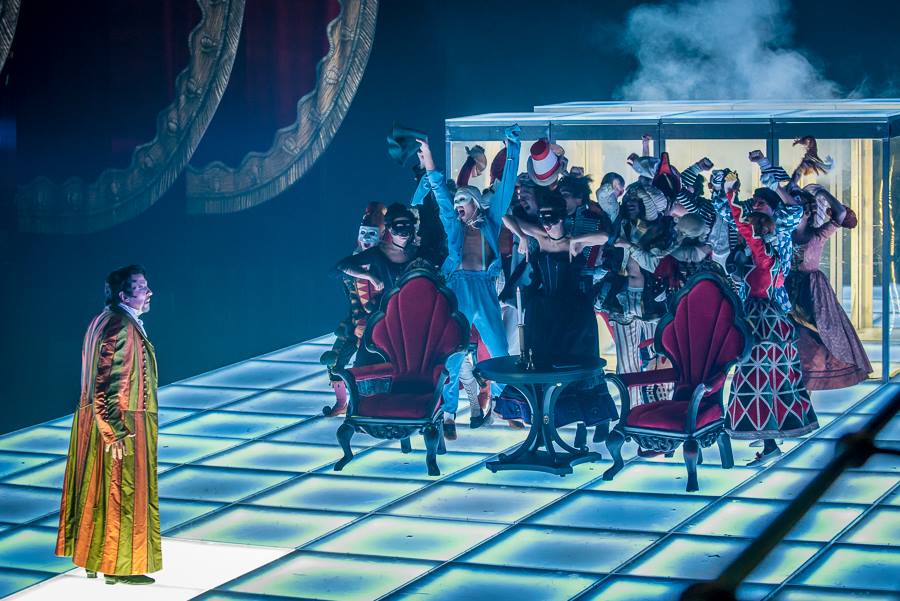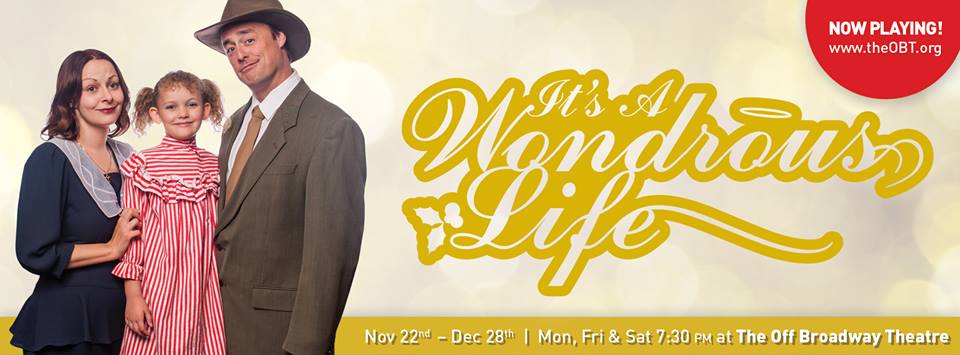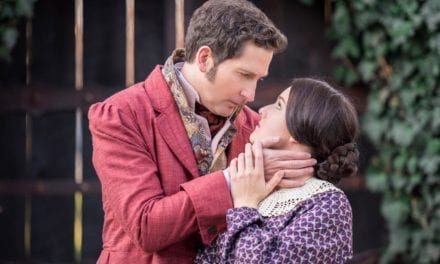WROCŁAW, POLAND — Thanks to the generous financial support of the Foundation of the American Theatre Critics Association (and the kindness of my boss to let me miss a few days of work), I spent a six days in eastern Poland attending the 2016 Theatre Olympics. While in Poland I was fortunate enough to attend a multiday young critics’ seminar (sponsored by the International Association of Theatre Critics) and—of course—I saw some plays.
Aside from the occasional touring company and the BYU Off the Map international theatre festival, Utahns get few opportunities to see international theatre. Therefore, I think it is particularly important for me to give a report on the productions I saw at the festival. These productions represent a wide cross-section of European theatre, and I believe there is value in writing about them for an American audience.
Masquerade: Recollections of the Future

A scene from Masquerade: Recollections of the Future.
Produced by Alexandrinsky Theatre (Russia, performed in Russian with English and Polish subtitles), directed by Valery Fokin. This show recreates scenes from a 1917 production of Masquerade by legendary director Vsevolod Meyerhold. But it is not just an adaptation. Rather, these scenes were interwoven with modern material to create a new pieces that has echoes of the past and present.
My first production at the Theatre Olympics was also the most visually satisfying. The mix of modern visual aesthetics and the classical visual elements was fascinating, and the technical elements were superb. Phone booth-sized Plexiglas compartments could rise up from the stage floor in many locations on the stage, and seeing the sterile white light and plastic surrounding a colorful masked harlequin or an opulent ball gown was stunning. The only major drawbacks of this production were lagging second act and the acting style that was entirely too subtle for large stage. But with the director’s goal being a tribute to the Russian theatre of a century ago, the show succeeded in its goals and was a great introduction to the sprawling, opulent tradition of Russian theatre.
Medeas: On Getting Across

Simona Sala, star of Medeas: On Getting Across. Photo by Magdalena Mądra.
Produced by Teatr ZAR (Poland, performed in Arabic, Farsi, Armenian, and Greek), directed by Jarosław Fret. Medeas: On Getting Across is a theatre-in-the-round piece that used sound and visual images to convey the difficulties and turmoil of refugees who flee their homeland and settle in strange countries. Drawing vaguely on the myth of Medea (who is less known as a refugee than she is as a filicide), the backdrop of the action on stage is the near-constant singing from three performers sitting around the edge of the stage. A small group of silent chorus members also function as stage hands to produce objects and move scenery as needed.
Although I empathize with the goals of this production, it made several basic mistakes that prevented a full enjoyment of the piece. One problem was the completely unnecessary set, which was placed at perimeter of the stage, meaning that it blocked the audience’s view of the action more often than not. (I thought that putting tall scenery at the perimeter of a theatre-in-the-round stage was an obvious no-no, but…) To make things worse, the exceptionally noisy machinery that raised and lowered the set served as a distraction from the hypnotic music. Another fundamental problem with this show was the fact that actions of the wordless performer (Simona Sala) never seemed to have any reason behind them. The actions seemed disconnected from one another, and if I had not read in advance that this play was supposed to explore the refugee condition, I would have been baffled during its entire 45-minute running time.
Lear

A scene from Lear.
Produced by Teatro della Toscana (Italy, performed in Italian with Polish subtitles), directed by Roberto Bacci. This adaptation of King Lear was the production that would seem most familiar to an American audience. In addition to being Shakespeare, the directing and acting style was pretty much the same as what American audiences see in traditionally staged Shakespeare productions, like at Pioneer Theatre Company or the Utah Shakespeare Festival. Although I could not understand the language, the adaptation (by Roberto Bacci and Stefano Geraci) followed the story of King Lear closely enough that I knew what was happening in every scene. This version slimmed the show down to 8 characters (Lear’s daughters’ husbands, for example, are excised) and clocked in at a quick 2 hours.
Perhaps because it was such a familiar style of theatre, I enjoyed this production greatly. Maria Bacci Pasello (in the far right of the photo) was a superb Lear who could make me feel sympathy for the aged king, even though I couldn’t understand a word she said. Bacci’s decision to make Edgar into a Caliban-like character while he’s feigning madness (though perhaps in this adaptation he’s not faking it) was innovative. The set consisted of seven rows of tall curtains that could open and close quickly to begin or end scenes, with most of the curtains painted to look like old concrete. This visual concept worked extremely well, as did the costumes, which matched the set and had a timeless feel to them, which matched the legendary, prehistoric British setting of the play.
C.O.R.P.uS.

A scene from C.O.R.P.uS. Photo by Aude-Marie Boudin.
Produced by Compagnie de l’Oiseau-Mouche (France, performed in French with Polish subtitles), no credited director. C.O.R.P.uS. starts out as a scientific lecture on biology and quickly changes into something else as the ghosts of famous directors and choreographers inhabit the bodies of the speaker’s models. Adding an element of complexity to the show is the fact that at least three of the performers had noticeable developmental disabilities.
Perhaps because of the language barrier, I struggled to make the connection between a biology lecture and the spirits of famous dancers. Another barrier to enjoyment of C.O.R.P.uS. is the lack of aesthetically pleasing dance. The performers dancing was OK, but it is too difficult to accept the idea that the ghost of Isadora Duncan or Valeska Gert was on stage. Another problem with the show is that the biology lecture portion seems to discuss evolution, and the actors with visible disabilities portrayed animals. To an American this had unfortunate implications that were difficult to ignore.
Go Down, Moses

Scene from Go Down, Moses.
Produced by Societas Raffaello Sanzio (Italy, performed in Italian with English and Polish subtitles), directed by Romeo Castellucci. Occasionally, I see a play that I do not fully comprehend, but I know there is some brilliance on stage. That is how I felt about Go Down, Moses. This show is an exploration of the feelings of loss for a child told in modern and prehistoric times. At the end of the play the two time period merge. Interspaced through these stories are visual images that range from the puzzling (like a rotating piece of machinery that gets items caught in it) to the disturbing (a very bloody scene of a woman having a medical emergency in a restroom).
Go Down, Moses had almost a cinematic feel to it; the play is performed behind a large, translucent, gauzy white cloth that resembles a movie screen in its dimensions. The play has almost constant sound effects loudly played through the speakers, and the actors match their movement to the pre-recorded audio. I don’t fully understand the connections of some of the scenes, and the way the two time period merge at the end is fascinating. Yet, the entire meaning of the piece is unclear, and even when I talked about it with other critics the next morning, most had figured out about as much of the show as I had.
Tisha B’Av

A scene from Tisha B’Av. Photo by Bartek Warzecha.
Produced by Teatr 21 (Poland, performed in Polish), directed by Justyna Sobczyk. Actors with autism or Down’s Syndrome dressed in physical education uniforms play children’s games under their coaches’ direction. As audience members watch, they listen to recordings of some of the actors’ mothers describing the experience of raising a child with Down’s Syndrome. The title refers to a Jewish holiday that marks destruction of the temple of Jerusalem in 70 AD, which is regarded as the saddest day in the Jewish calendar.
This play was a total waste of everybody’s time. For 40 minutes the audience watches actors play games like “keep away” or dodgeball. The connection between these games and Jewish culture is completely obscure. Only a written paper made the connection apparent: the director wished to showcase these actors because people with disabilities were among the first victims of the Nazi extermination program that was the Holocaust. But why are these games reminiscent of the abhorrent actions of the Nazis? Is it because competition sometimes brings out cruel actions in people? Is it because listening to their mothers’ stories reaffirmed these people’s humanity and right to a fulfilling life? Were the coaches demanding authority figures who gave orders and demanded obedience? I don’t think anyone who watches this play really knows. And even if one acknowledges a connection between the play’s message and the performance, so what? The play didn’t state anything that I didn’t already know. I know that people with disabilities can all lead happy lives and make positive contributions to their families’ well-being. I know that the Nazi’s actions were some of the most repulsive crimes in the history of mankind. Why did this play need to attempt to state these obvious truths?
On top of that, some of the actors clearly had difficulty following simple instructions (such as which way to face, or where to stand), which makes me think that they may have not have had the capacity to understand that they were in a play. As a result, the whole show has a distasteful undercurrent of exploitation.
Vidomi

Scene from Vidomi. Photo by Alexandra Galambova.
Produced by CHOREA Theatre (Poland, performed in Polish with English subtitles), directed and choreographed by Janusz Adam Bierdrzycki and Magdalena Paszkiewicz. The third show to feature actors with disabilities, Vidomi explores blindness through dance and speech. Two blind cast members at various times speak, participate in dance, or are physically isolated from the seeing cast members. All of this shows at various times the ways people with visual impairments are integrated or ignored by society.
Although this production did better than C.O.R.P.uS. or Tisha B’Av at integrating cast members with disabilities into a meaningful performance, the show was still trite at times. For one stretch of the show, one blind actress shouted about how she was not different. While nice, it reached the point of a cliché when she said, “I am still a person!” To an American the idea that people with disabilities need to affirm their personhood is quaint, because Americans don’t need to learn that the blind are people, too. Add in uninspiring choreography that was executed at the level of a good amateur cast in an arts council production and a show that was far too long, and Vidomi was a disappointment.
The Tree

Scene from The Tree. Photo by Rina Skeel.
Produced by Odin Teatret (Denmark, performed in English, Italian, and other languages), directed by Eugenio Barba. The Tree shows the devastating effect of war on society by showing the human toll of conflict. The titular tree serves as a symbol for the effects of war.
Have you ever had somebody tell you about their dream in great detail? The different events of the dream don’t seem connected at all, yet the person seems passionate about telling you everything about it because the dream is so important to them. But after listening politely for several minutes, you start to lose interest because the events aren’t real, and there seems to be no sign of an end. That is what it is like watching The Tree.
The Tree is the sort of play that gives avant-garde theatre a bad name, mostly because it embraced strange events and visual images that did not serve a purpose. When ideas did serve a purpose, such as forcing the audience to sit on uncomfortable rubber cylinders or the Vietnam War imagery, the ideas were dated. (Were Iraq and Afghanistan too topical?) But most of The Tree is nonsensical. Why did most of the actors wear clown noses? Why was one actor meditating for about one-third of the play? Why did the audience need to poke their heads through a thin, white cloth that dropped from the ceiling? What did the two monks have to do with the little girl or the Indian woman singing? Because of the hodgepodge of ideas all haphazardly thrown together, The Tree is a dull, joyless mess to sit through. It is the worst professional theatrical production I have ever seen, and I’m baffled why anyone thought this show was a good idea.





